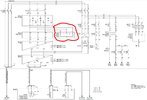gubavac111
New Member
I need to replace 9pcs of 68uF caps - https://www.ebay.com/itm/202885535604.
These caps are part of Sine wave filter for the Variable Frequency Drive that is running a big motor on the ship (drawing attached; note that drawing shows only 3 caps, but in reality it is 3 caps between each phases, so 9 in total).
My question is - is it necessary to perform a sort of "current injection" into these capacitors before applying operating voltage?
This procedure is supposed to reduce inrush current once the operating voltage is applied.
I've heard about this procedure from my colleague, but couldn't find any info on it online.
This procedure is supposed to reduce inrush current once the operating voltage is applied and prevent caps from getting damaged, if this makes any sense.
My opinion is this is not necessary because we already had a situation where the system was off for awhile and caps were completely discharged and, once the voltage was applied, it was all ok.
Any opinions?
These caps are part of Sine wave filter for the Variable Frequency Drive that is running a big motor on the ship (drawing attached; note that drawing shows only 3 caps, but in reality it is 3 caps between each phases, so 9 in total).
My question is - is it necessary to perform a sort of "current injection" into these capacitors before applying operating voltage?
This procedure is supposed to reduce inrush current once the operating voltage is applied.
I've heard about this procedure from my colleague, but couldn't find any info on it online.
This procedure is supposed to reduce inrush current once the operating voltage is applied and prevent caps from getting damaged, if this makes any sense.
My opinion is this is not necessary because we already had a situation where the system was off for awhile and caps were completely discharged and, once the voltage was applied, it was all ok.
Any opinions?



